What is Quick App?
The computer security experts have determined that Quick App is a potentially unwanted program (PUP) which falls under the family of Browser hijackers. A common tactic used by makers of PUPs is to modify web browser’s settings such as newtab page, default search provider and start page so that the affected web-browser goes to a web site under the author’s control. You need to follow the few simple steps below to remove Quick App and protect you from other browser hijackers and potentially unwanted applications.
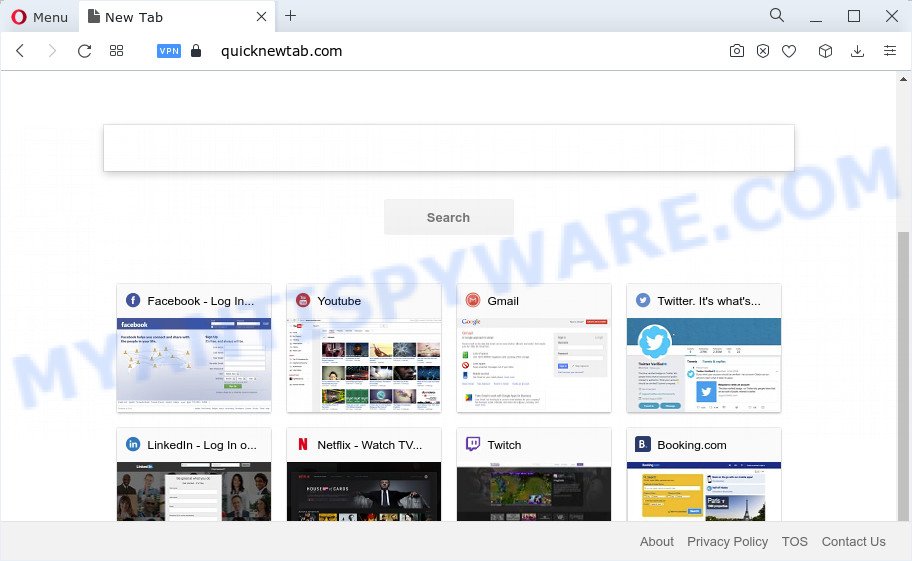
Quick App is a browser hijacker
Most often, browser hijackers promote fake search engines by setting their address as the default search engine. In this case, the hijacker installs quicknewtab.com as a search engine. This means that users whose browser is affected with the Quick App browser hijacker are forced to visit quicknewtab.com each time they search in the Web, open a new window or tab. And since quicknewtab.com is not a real search engine and does not have the ability to find the information users need, this web-page redirects the user’s web-browser to the Yahoo or Google search engine. The developers of Quick App are most probably doing this to make advertisement money from the advertisements displayed in the search results.
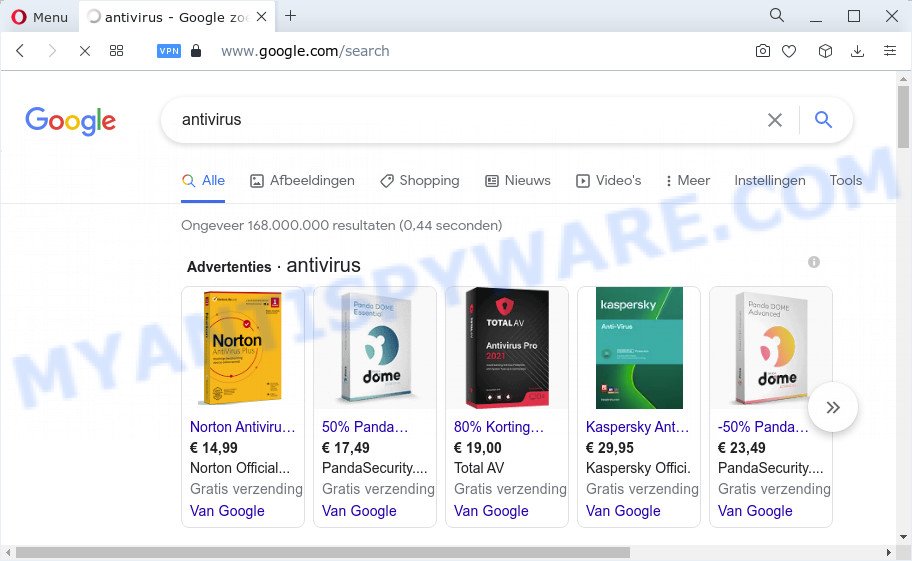
Quick App redirects user seaches to quicknewtab.com
In addition to the above, Quick App is able to collect lots of your confidential data that may be later transferred to third parties. You don’t know if your home address, account names and passwords are safe. And of course you completely don’t know what will happen when you click on any advertisements on the Quick App webpage.
If you realized any of the symptoms mentioned above, we advise you to complete guide below to get rid of browser hijacker and remove Quick App from Edge, Mozilla Firefox, Google Chrome and Microsoft Internet Explorer.
How can a browser hijacker get on your PC
Browser hijackers and PUPs spreads with a simple but quite effective way. It’s integrated into the setup file of various free programs. To avoid hijacker, you just need to follow a few simple rules: carefully read the Terms of Use and the license, select only a Manual, Custom or Advanced installation method, which enables you to make sure that the program you want to install, thereby protect your PC system from the browser hijacker such as the Quick App.
Threat Summary
| Name | Quick App |
| Type | search engine hijacker, homepage hijacker, browser hijacker, PUP, redirect virus |
| Associated domains | quicknewtab.com |
| Affected Browser Settings | search provider, new tab URL, start page |
| Distribution | fake software updaters, suspicious pop up ads, free applications setup files |
| Symptoms | You experience lots of of unwanted ads. Every time you perform an Internet search, your browser is redirected to another web site. There is an unwanted application in the ‘Uninstall a program’ section of your Control Panel. An unexpected web-browser toolbar appears in your internet browser. Unwanted changes in your web-browser such as displaying new tabs you did not open. |
| Removal | Quick App removal guide |
How to remove Quick App from Google Chrome, Firefox, IE, Edge
We are presenting various ways to delete Quick App from the Internet Explorer, Firefox, Edge and Chrome using only internal Windows functions. Most of hijackers and PUPs can be removed via these processes. If these steps does not help to delete Quick App, then it is better to run free malware removal tools linked below.
To remove Quick App, complete the following steps:
How to manually delete Quick App
Steps to remove Quick App without any programs are presented below. Be sure to carry out the step-by-step instructions completely to fully remove this browser hijacker.
Delete unwanted or recently added applications
The best way to begin the computer cleanup is to remove unknown and suspicious apps. Using the Windows Control Panel you can do this quickly and easily. This step, in spite of its simplicity, should not be ignored, because the removing of unneeded software can clean up the Edge, Chrome, Internet Explorer and Mozilla Firefox from advertisements hijackers and so on.
Press Windows button ![]() , then press Search
, then press Search ![]() . Type “Control panel”and press Enter. If you using Windows XP or Windows 7, then click “Start” and select “Control Panel”. It will display the Windows Control Panel like the one below.
. Type “Control panel”and press Enter. If you using Windows XP or Windows 7, then click “Start” and select “Control Panel”. It will display the Windows Control Panel like the one below.
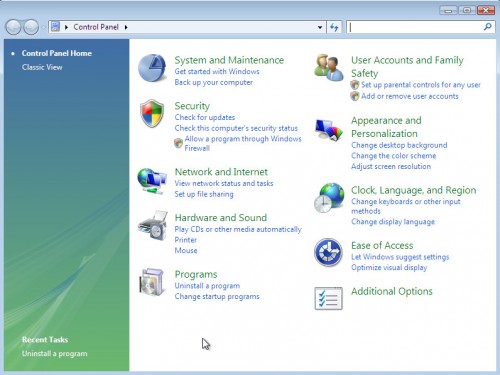
Further, press “Uninstall a program” ![]()
It will open a list of all programs installed on your device. Scroll through the all list, and remove any dubious and unknown apps.
Remove Quick App hijacker from internet browsers
If you’re still seeing Quick App browser hijacker that won’t go away, you might have malicious plugins installed on your browser. Check your browser for unwanted extensions using the steps below.
You can also try to remove Quick App hijacker by reset Chrome settings. |
If you are still experiencing issues with Quick App hijacker removal, you need to reset Firefox browser. |
Another method to remove Quick App hijacker from Internet Explorer is reset Internet Explorer settings. |
|
Automatic Removal of Quick App
If you’re not expert at computer technology, then we advise to run free removal utilities listed below to get rid of Quick App browser hijacker for good. The automatic solution is highly recommended. It has less steps and easier to implement than the manual method. Moreover, it lower risk of system damage. So, the automatic Quick App removal is a better option.
Remove Quick App browser hijacker with Zemana
Zemana Anti-Malware (ZAM) is an amazing tool to remove Quick App hijacker from your web browser. It also deletes malware and adware from your computer. It improves your system’s performance by deleting PUPs.
Visit the following page to download the latest version of Zemana Free for Microsoft Windows. Save it on your Desktop.
165074 downloads
Author: Zemana Ltd
Category: Security tools
Update: July 16, 2019
When the downloading process is complete, close all apps and windows on your computer. Open a directory in which you saved it. Double-click on the icon that’s named Zemana.AntiMalware.Setup as shown below.
![]()
When the installation starts, you will see the “Setup wizard” that will allow you setup Zemana Free on your computer.
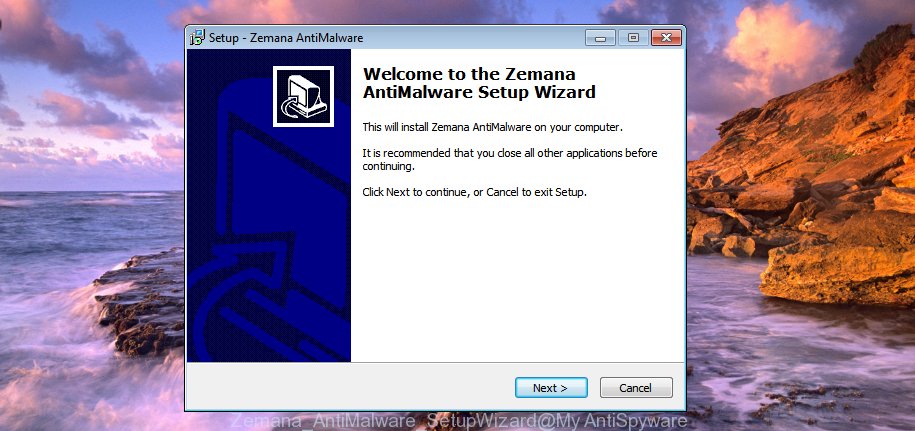
Once setup is complete, you will see window as displayed below.
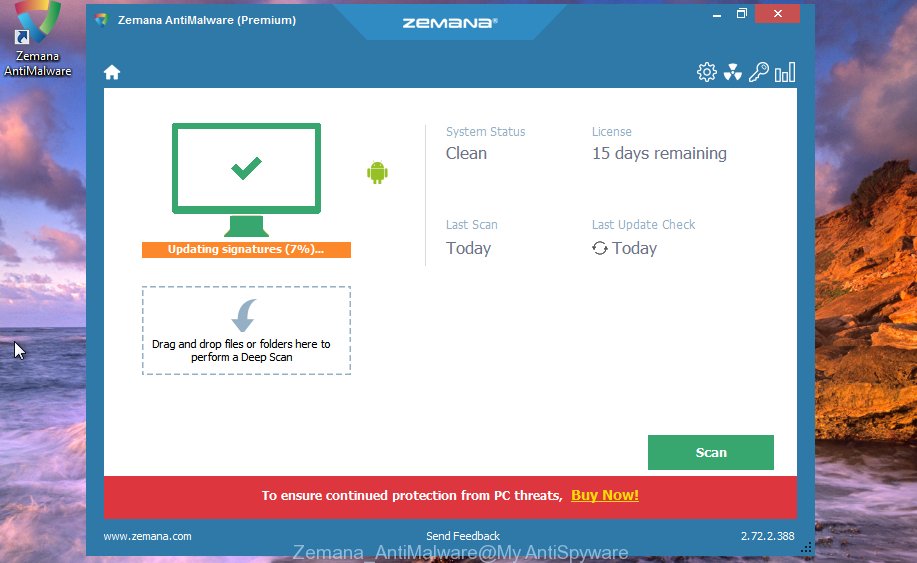
Now press the “Scan” button to start checking your PC system for the Quick App browser hijacker. A system scan can take anywhere from 5 to 30 minutes, depending on your PC. When a threat is found, the number of the security threats will change accordingly. Wait until the the checking is finished.

After the system scan is done, the results are displayed in the scan report. Once you have selected what you want to delete from your personal computer press “Next” button.
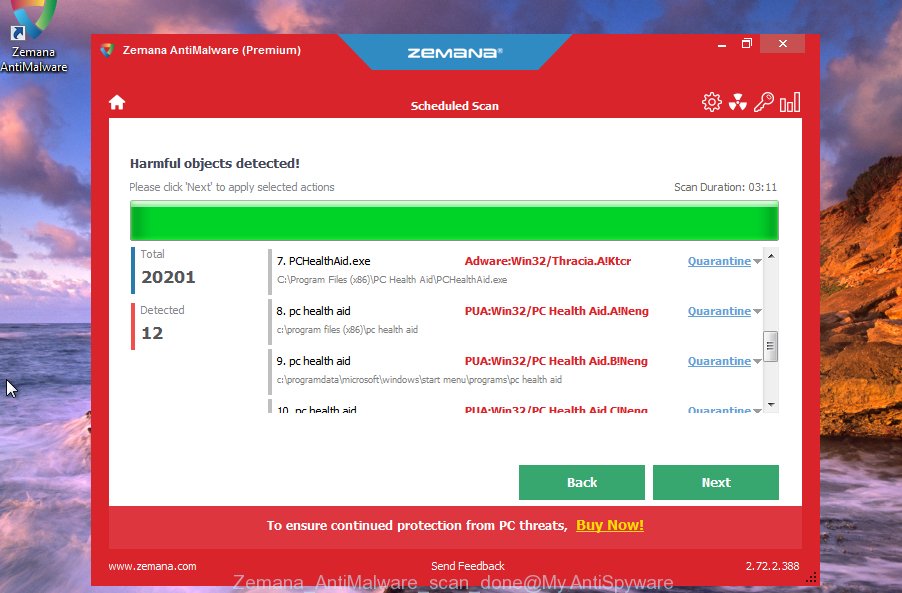
The Zemana AntiMalware (ZAM) will remove Quick App hijacker and move the selected items to the Quarantine.
Get rid of Quick App browser hijacker and malicious extensions with Hitman Pro
HitmanPro will help get rid of Quick App browser hijacker that slow down your computer. The browser hijackers, adware software and other potentially unwanted apps slow your browser down and try to force you into clicking on misleading ads and links. HitmanPro removes the hijacker and lets you enjoy your personal computer without Quick App hijacker.
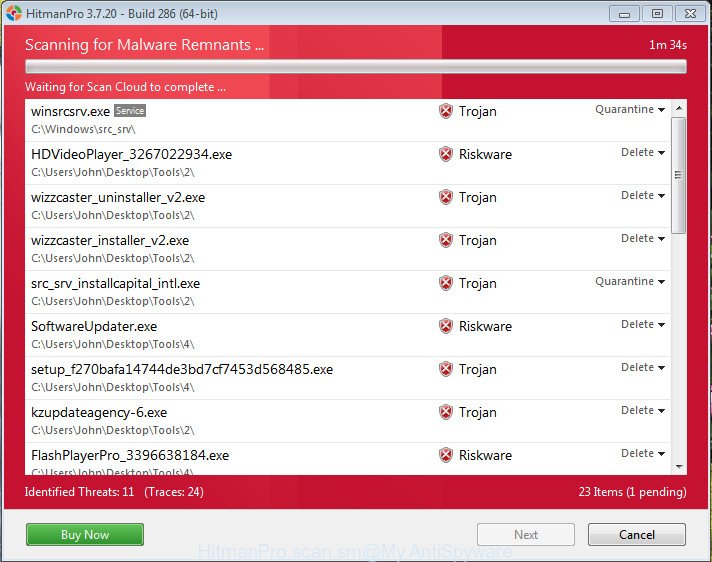
- Installing the HitmanPro is simple. First you’ll need to download HitmanPro on your PC system by clicking on the following link.
- When the downloading process is finished, double click the Hitman Pro icon. Once this utility is opened, click “Next” button to perform a system scan with this tool for the Quick App browser hijacker. While the HitmanPro tool is scanning, you can see number of objects it has identified as being affected by malware.
- Once HitmanPro has finished scanning, Hitman Pro will display a list of all items detected by the scan. In order to delete all threats, simply click “Next” button. Now click the “Activate free license” button to start the free 30 days trial to remove all malware found.
Delete Quick App hijacker with MalwareBytes AntiMalware
We suggest using the MalwareBytes Free. You can download and install MalwareBytes to detect and delete Quick App browser hijacker from your PC system. When installed and updated, this free malware remover automatically detects and removes all threats exist on the computer.
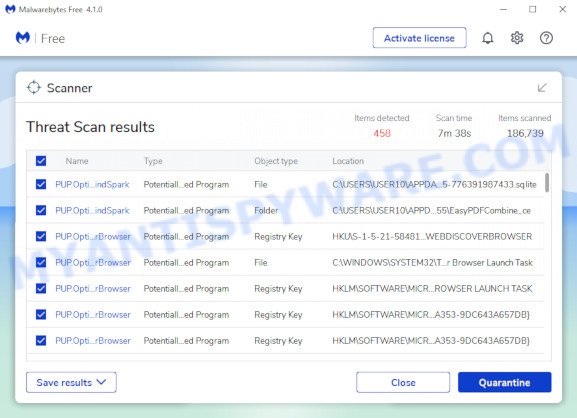
- First, click the link below, then press the ‘Download’ button in order to download the latest version of MalwareBytes Free.
Malwarebytes Anti-malware
327297 downloads
Author: Malwarebytes
Category: Security tools
Update: April 15, 2020
- At the download page, click on the Download button. Your internet browser will show the “Save as” dialog box. Please save it onto your Windows desktop.
- After the downloading process is complete, please close all apps and open windows on your computer. Double-click on the icon that’s named MBSetup.
- This will open the Setup wizard of MalwareBytes AntiMalware onto your computer. Follow the prompts and don’t make any changes to default settings.
- When the Setup wizard has finished installing, the MalwareBytes Anti Malware (MBAM) will launch and show the main window.
- Further, press the “Scan” button . MalwareBytes Free application will scan through the whole computer for the Quick App hijacker. A scan can take anywhere from 10 to 30 minutes, depending on the count of files on your PC and the speed of your device. When a malware, adware or PUPs are found, the number of the security threats will change accordingly.
- After that process is complete, MalwareBytes Free will open a list of found threats.
- Once you’ve selected what you want to remove from your computer click the “Quarantine” button. After that process is complete, you may be prompted to restart the device.
- Close the AntiMalware and continue with the next step.
Video instruction, which reveals in detail the steps above.
How to stop Quick App redirect
To put it simply, you need to use an ad blocking tool (AdGuard, for example). It’ll stop and protect you from all unwanted web pages such as quicknewtab.com, ads and pop ups. To be able to do that, the adblocker program uses a list of filters. Each filter is a rule that describes a malicious web-site, an advertising content, a banner and others. The ad-blocker program automatically uses these filters, depending on the webpages you’re visiting.
- Click the following link to download the latest version of AdGuard for MS Windows. Save it on your Windows desktop.
Adguard download
26905 downloads
Version: 6.4
Author: © Adguard
Category: Security tools
Update: November 15, 2018
- Once the downloading process is complete, start the downloaded file. You will see the “Setup Wizard” program window. Follow the prompts.
- Once the installation is finished, click “Skip” to close the setup application and use the default settings, or click “Get Started” to see an quick tutorial which will assist you get to know AdGuard better.
- In most cases, the default settings are enough and you do not need to change anything. Each time, when you run your device, AdGuard will launch automatically and stop undesired ads, block Quick App redirects, as well as other harmful or misleading web pages. For an overview of all the features of the program, or to change its settings you can simply double-click on the icon called AdGuard, that can be found on your desktop.
Finish words
Once you’ve done the instructions shown above, your device should be clean from this browser hijacker and other malware. The MS Edge, Microsoft Internet Explorer, Mozilla Firefox and Google Chrome will no longer open the quicknewtab.com website. Unfortunately, if the few simple steps does not help you, then you have caught a new hijacker, and then the best way – ask for help.
Please create a new question by using the “Ask Question” button in the Questions and Answers. Try to give us some details about your problems, so we can try to help you more accurately. Wait for one of our trained “Security Team” or Site Administrator to provide you with knowledgeable assistance tailored to your problem with the Quick App browser hijacker.



















